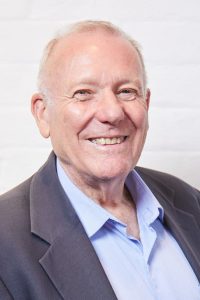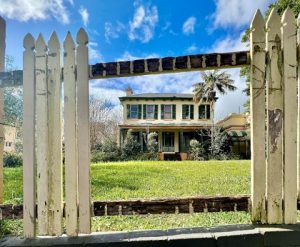 by Ian Stephenson, September 2022, from Bulletin 8 of 2022
by Ian Stephenson, September 2022, from Bulletin 8 of 2022
It gives me great pleasure to present the President’s Report for the Society’s 53rd year.
Glebe’s well-defined physical boundaries, unusually intact and layered urban fabric, remarkable history, topography and demography make it a unique suburb. Perhaps the most important quality of all is Glebe’s residents’ love of place and sense of identity. The Society has been working to nurture Glebe’s special magic for over 50 years. Our three pillars, community, environment and heritage, remain as relevant as ever. The fact that our membership grew by 10% to 449 shows we continue to engage the people of Glebe.
Productive people don’t linger over what they have done but are busy with the current project and thinking about the next one. The Society is like that, but it is useful to mention some of our achievements. In the last year:
- We produced ten Bulletins that featured planning issues, submissions by the Society, original research about the people of Glebe and articles about our builders, architects and natural environment.
- We improved our website to make it easier to access the phenomenal amount of research embodied in our Bulletins.

- We were quick to get Glebe events up and running at the end of lockdown. In November last year architect Philip Thalis gave a talk on his vision for the St Phillips estate. This year Dorothy Davis, the impresario of Glebe Guided Walks, has produced a remarkable walks program. Glebe is a life-enriching place full of character. My favourite memory from this year’s Walks is Meredith Burgmann talking about an Anarchists conference in the Glebe Presbyterian Church (she said it was quite well organised) and buying flares from a Glebe ships chandler with which to disrupt the 1971 Springboks tour.
- We nominated 27 Catherine St, Forest Lodge, the home of Charles Perkins during the Freedom Rides for the NSW Government’s inaugural Blue Plaque scheme. I would like to thank our local member Jamie Parker for putting the nomination forward. It was included in the first 30 plaques for the State. We have 20 other nominations ready to go, including important feminist and Indigenous landmarks and the former homes of the famous, infamous and obscure.
- Asa Wahlquist represented the Society on the Fish Market Community representative group and prepared important submissions on the Blackwattle Bay State Significant Development and Bays West Strategy.
- The Blue Wren Subcommittee, our ecology arm, has continued their work in improving habitat and monitoring fauna. The number of bird species has increased over the previous year. Superb Fairy Wrens, small birds displaced by the more aggressive Currawongs and Noisy Miners, are returning to Glebe and fish, pelicans, turtles, eels, ducks and herons have returned to Johnstons Creek.
- We joined other residents’ groups led by Mary Mortimer of Pyrmont in lobbying Sydney City Council to make community centres more accessible.
- In the planning area, we met with Sydney Councillors and planners to seek improvements to the Local Environment Plan and Development Control Plan to provide greater clarity for property owners about the design of new development in heritage conservation zones. We requested greater recognition of the role conservation plays in reducing greenhouse gases and more guidance about making buildings in conservation areas more environmentally sustainable without compromising their significance and that of the Heritage Conservation Area.
- We shared our knowledge about Glebe’s buildings and made many submissions in relation to development applications.
-

A different slant on community consultation, inviting input/ideas for the future of Wentworth Park (photo: Phil Vergison)
We participated in the review of the plans of management for Glebe’s Crown Land reserves. We recommended an integrated plan of management for Wentworth Park predicated on the dog track licence not being renewed. Pleasingly the Council is now doing this. We also recommended that higher-level planning documents for Sydney include Wentworth Park as a visionary project. This includes retaining the legibility of the topography on the park’s western edge, not burying it in a mountain of masonry, recovering and celebrating the area’s Indigenous significance – as well as a sense of the post-colonial gardenesque layout – and creating a green link which connects and interprets the former bay’s relationship to its extant headwaters, Lake Northam in Victoria Park. We believe it can become a park like no other. - The Society has long advocated the restoration of the Glebe Island Bridge. There is hope on this front as it is supported by the State Government’s Bays West Plan.
Key challenges are set out below.
- The Bridge Rd cycleway. It was introduced as a ‘pop-up’ cycleway during COVID. We support safe cycleways in and around Glebe, but this cycleway is unsafe. Bridge Rd is a narrow arterial road; the cycleway merges with the roadway in several places, has blind corners and crosses many private driveways, entrances and side streets along its path. Many of these hazards cannot be mitigated without compromising all road users and residents. We requested Minister Stokes not to make the cycleway permanent and to look at all the options for delivering a safe cycleway, including better alternatives to a narrow arterial road where the cycleway merges with traffic. Despite this and meetings with policy advisors, we have received no advice of how the government intends to fix this problem.
- Although the revised Blackwattle Bay State Significant development includes some of the things we requested, such as a wider foreshore walk, the buildings proposed are still too tall and the open space too overshadowed.
-

The condition of Bidura’s front fence is a security risk to this State Heritage-listed building and a visual blight on Glebe (photo: Phil Vergison)
Bidura, the State Heritage-listed house in Glebe Point Rd, designed and lived in by the great Victorian architect Edmund Blacket, remains a concern. - Large parts of Glebe are owned by the NSW Land and Housing Corporation. These include the former church estates and land around Lyndhurst, which was remediated after the freeway demolitions of the 1970s. These precincts benefited from visionary planning in the 1970s and 1980s, where 19th-century houses were restored, renovated and retained as public housing, and low-rise infill added, designed to respect the conservation’s scale, form and topography areas. The Land and Housing Corporation has been selling the old houses and redeveloping the infill sites. Last November, a development application was approved for two eight-storey buildings in Cowper St.
- The Land and Housing Corporation now plans to demolish 82 Wentworth Park Rd. It is part of an ensemble of three buildings (the other two being 49-55 and 61-63 Bellevue St) whose broken forms, pitched roofs and verandas use the topography to complement and reinforce Glebe’s traditional urban edge with Wentworth Park. The cost of demolition and rebuilding is greater than refurbishment. This is a well-built and beautifully designed building – what is proposed is not.
- Demolition comes at a personal cost, as it dislocates long-term tenants. Nor is it an environmentally sustainable option because the materials, transportation and construction processes for new buildings are all carbon intensive. Existing buildings already embody significant CO₂ emissions, which makes it all the more important to upgrade and refurbish – rather than demolish and rebuild.
-

Ian Stephenson, Glebe Society, Jenny Leong, member for Newtown representing Jamie Parker, Carolyn Ienna, a resident of 82 Wentworth Park Rd, Councillor Jess Scully, Councillor Sylvie Ellsmore, Denis Doherty Hands Off Glebe and John Engeler, Shelter NSW.
The scheme provides little increase in the number of bedrooms, and this will be at great expense. It would be much better socially, environmentally and economically to refurbish, retrofit and provide additional housing through sensitive infill development. The Society has been working with our compatriot organisation Hands Off Glebe on this issue. - We will continue to advocate for the State Government to manage its Glebe estates in a more rational and humane way.
I would like to thank Virginia Simpson-Young, our Bulletin editor, for her tireless work, Dorothy Davis for her leadership in reactivating our Guided Walks program and our committee members Mark Stapleton, Jude Paul, Jane Gatwood, Ted McKeown, Allan Hogan, Brian Fuller, Judy Vergison, Andrew Wood, Asa Wahlquist, Janet Wahlquist, Mary-Beth Brinson and Michael Morrison.










There are no comments yet. Please leave yours.